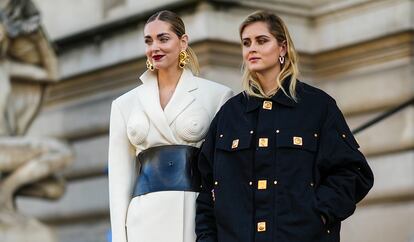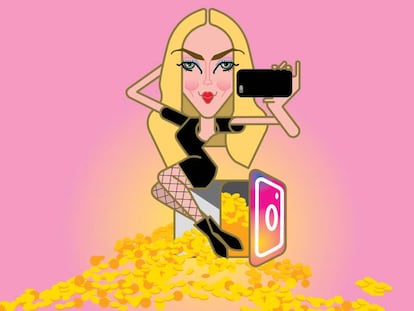The digital wage gap: women influencers may be the majority, but they still earn less
Studies confirm that the world of online content creators is just like any other work environment: race and gender have an impact on pay. Only the fashion industry is free from that inequality

Several years ago, Wired magazine asked why, in the digital world, women were called “influencers” and yet men were “content creators.” The distinction existed across industries, from the infamously sexist video games sector, where men predominate, to fashion, where women are more numerous. Some social media celebrities may find the increasingly reviled word “influencer” too frivolous. But on their platforms, as in society in general, women’s work has less value than men’s: females take on the passive role of influencing, while males are actively “producing.”
Since the Wired article, several digital marketing agencies have wondered whether this difference in names had any real consequences. The answer, unfortunately, is yes. A 2019 study by the HypeAuditor platform concluded that male influencers earned 7% more. More than 1,600 influencers of both genders, and with audiences from 20,000 to one million, were polled. The gender gap widened as the number of followers grew. The most famous men received, on average, €2,500 per Instagram post, while women made €2,200.
Over the years, the gap has not narrowed. A 2021 study by Izea, one of the best-known influencer marketing agencies, revealed that, in some cases, last year, male digital celebrities earned an average of around €2,800 euros per post, 30% more than their female counterparts. The same study details that women receive 85% of the sponsorships, but their rates are lower.
Non-Caucasian digital celebrities, according to this same study, can find their earnings reduced by as much as 90%. “I created my page out of sheer frustration. I wanted to show how this market really works,” digital marketing executive Adesuwa Ayaji recently told Bustle magazine. During the last year, her Instagram account @influencerpaygap, now inactive, has published messages from influencers denouncing the injustices of their work, from a Black TikToker with 300,000 followers who was going to get paid €20 per video, to disabled women whom a brand wanted to pay “in visibility.”
Some may see the digital content world as an industry whose workers enjoy frequent gifts, easy money and short working hours. But it involves the same gender and racial prejudices as any other workplace, “with the aggravating circumstance that here the rates are not fixed. Some have a manager who negotiates for them, others don’t, and in the end issues such as insecurity or the need for collaborations work against them,” says a digital marketing specialist who prefers not to reveal his name. The data proves him right. According to another report published two months ago by the agency Sevensix, 78% of influencers feel insecure putting a price on their collaborations.
According to The Guardian, last winter’s list of the highest paid gamers in the world includes its first woman, Sasha Scarlett Hosting, at number 367. Only two others, Xiao Meng “Liooon” Li and Katherine “Mystik” Gunn, achieve six-figure annual earnings. On Twitch, only three of the 100 most profitable players are women.
Fashion is perhaps the only field that escapes economic inequality, mainly because women are the majority and because the field has traditionally been seen as women’s work. “Many male fashion influencers have a female fan base,” explains an account executive of a fashion brand agency. “That changes things a lot, because they don’t usually follow them out of aspiration, but because of their physical appearance or because they like their content,” he says. They charge more – because, in essence, they are more famous – and, he says, “they are more determined when negotiating.”
But the issue is both economic and structural. In traditional advertising, according to a recent study, many brands are still reluctant to portray women in professional settings and rely on traditional roles to comfort the consumer. Among the thousands of visual inputs that we unconsciously receive every day, most perpetuate those prejudices that make men “content generators” and women mere “influencers.”
Tu suscripción se está usando en otro dispositivo
¿Quieres añadir otro usuario a tu suscripción?
Si continúas leyendo en este dispositivo, no se podrá leer en el otro.
FlechaTu suscripción se está usando en otro dispositivo y solo puedes acceder a EL PAÍS desde un dispositivo a la vez.
Si quieres compartir tu cuenta, cambia tu suscripción a la modalidad Premium, así podrás añadir otro usuario. Cada uno accederá con su propia cuenta de email, lo que os permitirá personalizar vuestra experiencia en EL PAÍS.
¿Tienes una suscripción de empresa? Accede aquí para contratar más cuentas.
En el caso de no saber quién está usando tu cuenta, te recomendamos cambiar tu contraseña aquí.
Si decides continuar compartiendo tu cuenta, este mensaje se mostrará en tu dispositivo y en el de la otra persona que está usando tu cuenta de forma indefinida, afectando a tu experiencia de lectura. Puedes consultar aquí los términos y condiciones de la suscripción digital.
More information
Últimas noticias
Most viewed
- Sinaloa Cartel war is taking its toll on Los Chapitos
- Oona Chaplin: ‘I told James Cameron that I was living in a treehouse and starting a permaculture project with a friend’
- Reinhard Genzel, Nobel laureate in physics: ‘One-minute videos will never give you the truth’
- Why the price of coffee has skyrocketed: from Brazilian plantations to specialty coffee houses
- Silver prices are going crazy: This is what’s fueling the rally











































